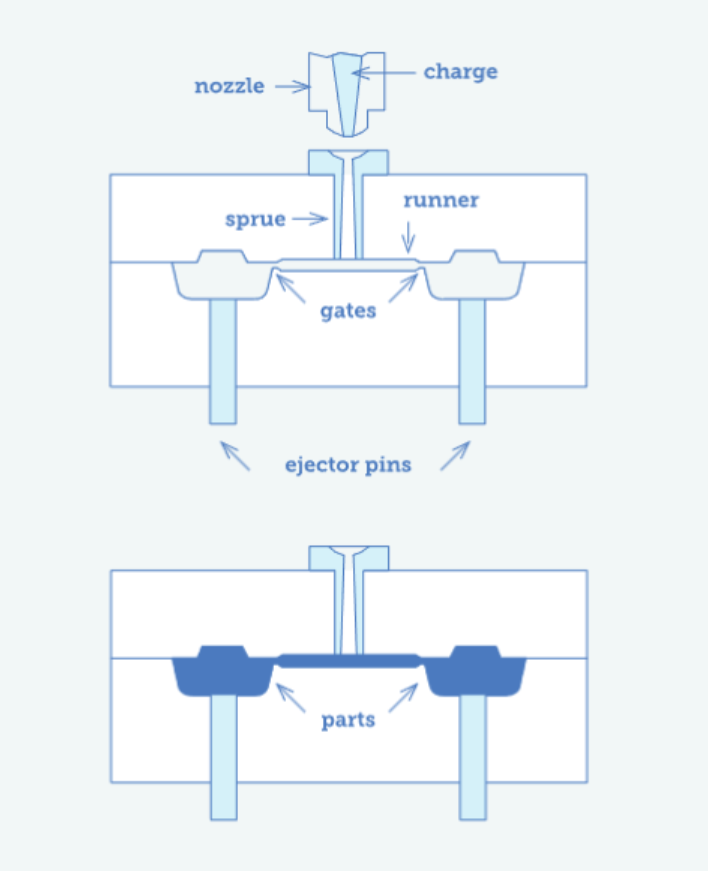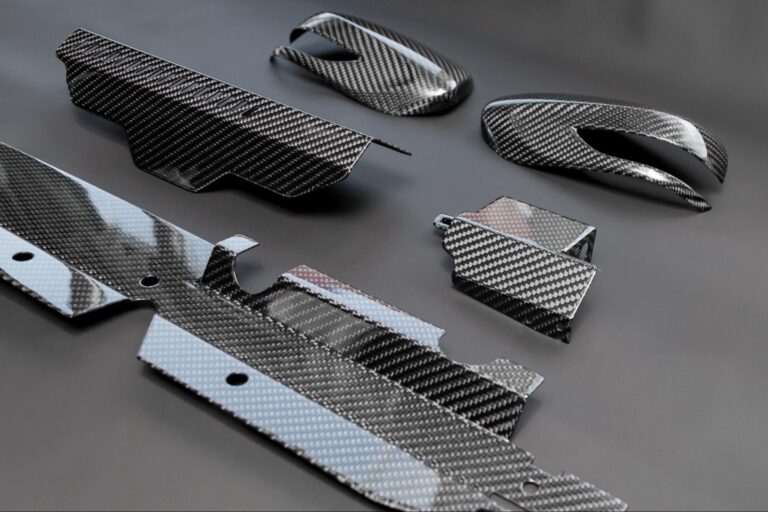Time to read: 7 min
Investment casting, also known as lost wax casting or investment molding, is a precision casting process that produces complex metal components with tight tolerances and excellent surface finishes. It involves creating a wax pattern, encasing it in a ceramic mold, melting out the wax, and pouring molten metal into the mold cavity.
This article details each process step, compares investment casting to other metal casting techniques, outlines material options, and provides criteria for choosing a reliable investment casting foundry. Before you invest in tooling for this process, read on to make sure it is the best fit for your products.

Understanding the Investment Casting Process
The investment casting process transforms a wax pattern into a high-quality metal part through a series of controlled steps. It delivers complex designs in near-net shapes requiring minimal post-processing. Its accuracy and repeatability stem from the wax pattern’s ability to replicate intricate geometries and the ceramic mold’s smooth surface, making it ideal for parts like turbine blades or orthopedic implants.
Here is a detailed breakdown of the investment casting process, including technical considerations:
The Investment Casting Process in 6 Steps
- Creating the Wax Pattern
A wax pattern is created through injection molding to replicate the geometry of the final part, capturing details such as internal channels or sharp corners. The blend of paraffin and microcrystalline waxes maintains the pattern’s shape without deformation at injection temperatures of 70–90 °C, ensuring the mold cavity’s fidelity.
Patterns for series production are produced in precision dies, CNC-machined to ±0.01 mm tolerances, ensuring the part’s dimensional accuracy. Engineers must design patterns with a 1–2.5% shrinkage allowance to account for wax and metal cooling, using simulation tools like Moldflow for optimization.
- Assembling Wax Patterns Into a Tree
Multiple wax patterns are manually or robotically bonded to a central wax sprue using heated tools or adhesive wax, forming a tree structure that allows for the simultaneous casting of 10–50 parts. While patterns are typically molded individually, complex designs may incorporate tree elements during injection molding to reduce the number of assembly steps. Proper alignment, verified by vision systems, prevents casting defects like incomplete fills.
The sprue and runner system, optimized using CAM software for manufacturing precision, ensures uniform metal flow and minimizes turbulence. This design reduces per-part costs by 20–30% for medium volumes (100–5,000 parts) by enabling batch casting and minimizing material waste. Automated robotic assembly enhances consistency, reducing misalignment risks by 15–20%.
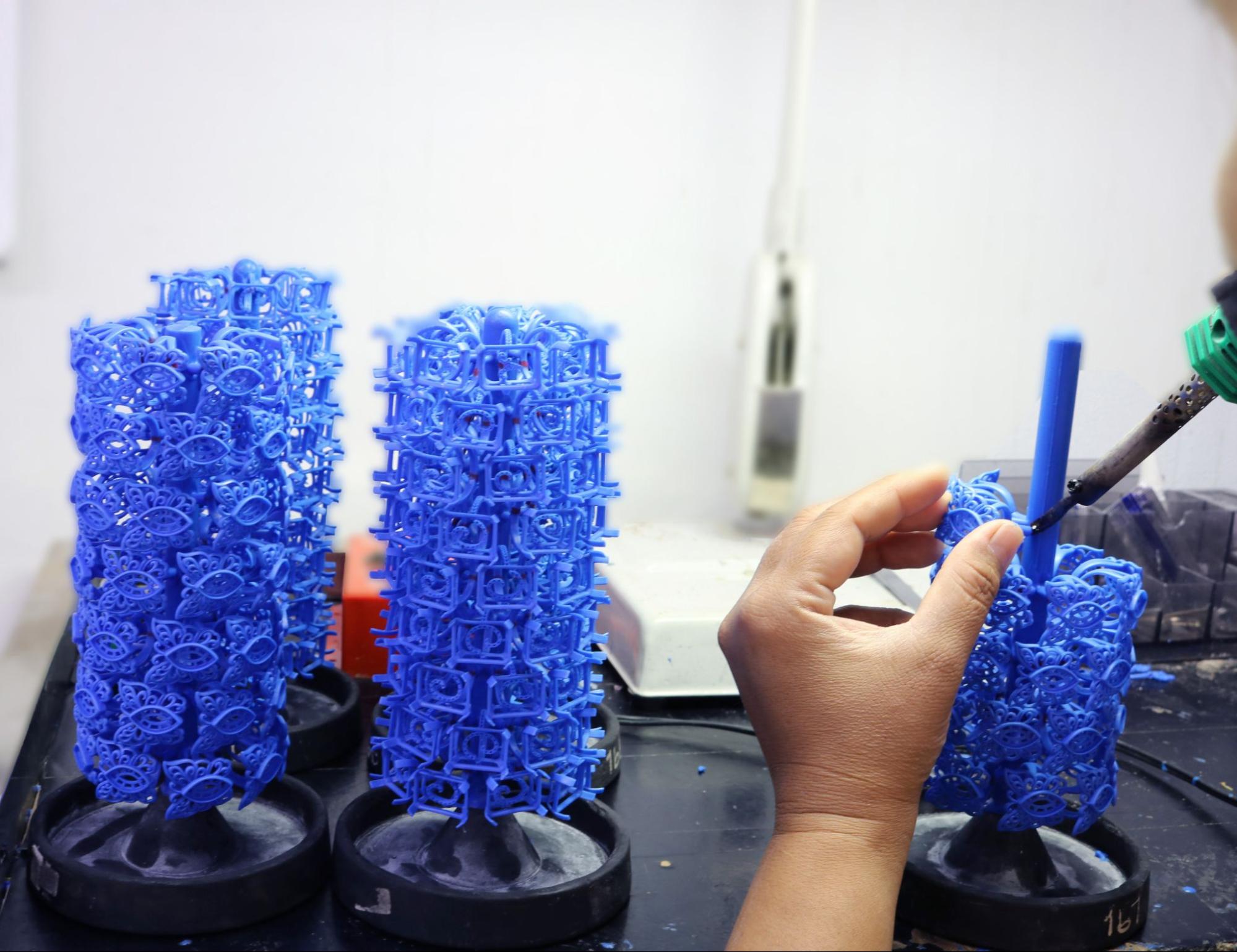
- Applying the Ceramic Shell Coating
The wax tree is dipped into a ceramic slurry containing colloidal silica as a binder, ceramic flour (e.g., zirconia, fused silica), and additives for thermal stability. Over 6–8 dipping and drying cycles, fine refractory sand (e.g., alumina, aluminum silicates) is applied as a stucco coating, building a 5–10 mm thick shell.
Each layer dries for 4–12 hours under controlled humidity to prevent cracking. The shell’s strength (up to 10 MPa) resists thermal stresses from molten metal (1,400–1,600 °C) and cooling, as well as pressures from gravity or vacuum-assisted pouring (0.1–0.5 MPa). This durability is essential for all mold geometries to maintain cavity integrity. Engineers monitor the slurry composition, pH, and temperature, alongside viscosity, to prevent voids and ensure mold quality, which is critical for part accuracy.
- Dewaxing and Preheating
The wax is melted out of the ceramic shell in an autoclave at 150–200 °C and 7–10 bar steam pressure, leaving a hollow ceramic mold cavity. This dewaxing step, central to lost wax casting, ensures a clean, residue-free cavity for accurate metal replication. The mold is then preheated to 540–1,090 °C to prepare it for molten metal.
Preheating minimizes thermal shock, which could crack the shell due to rapid temperature gradients. It also prevents premature metal solidification against the mold walls, ensuring the complete filling of intricate details. Additionally, preheating reduces porosity by 15–20% by maintaining uniform mold temperatures, which limits gas entrapment and shrinkage voids, enhancing part density and structural integrity.
- Pouring the Molten Metal
Molten metal (e.g., 17-4 PH stainless steel, Ti-6Al-4V) at 1,400–1,600 °C is poured into the mold using gravity, vacuum assist, or centrifugal methods. Vacuum casting, common for titanium, minimizes oxidation, ensuring defect-free surfaces. Pouring speed (0.5–2 kg/s) is crucial to prevent cold shuts, requiring precise control through automated systems.
- Cooling, Shell Removal, and Finishing
After solidification (10–60 minutes, depending on the alloy), the ceramic shell is removed using vibration or high-pressure water jets (100–200 bar). Parts are cut from the sprue and finished with grinding, sandblasting, or polishing to achieve 32–63 µin Ra (a measure of surface roughness, where lower values indicate smoother finishes). Secondary machining may be needed for ultra-tight tolerances (±0.001″), which is often achieved through precision CNC machining.
Investment Casting vs. Other Casting Methods
Investment casting stands out among metal casting techniques due to its precision and versatility. The table below compares it with other common methods, highlighting differences in surface finish, accuracy, complexity, material options, tooling costs, and volume suitability.
| Casting Method | Surface Finish | Dimensional Accuracy | Part Complexity Capability | Material Options | Tooling Cost | Volume Suitability |
| Investment Casting | Excellent (32–63 µin Ra) | ±0.005″–0.015″ | Very High | Extensive (steels, superalloys) | Medium | 500–5,000 parts |
| Die Casting | Good (60–120 µin Ra) | ±0.004″–0.010″ | High | Limited (primarily Al, Zn, Mg) | High | 5,000–10,000+ parts |
| Sand Casting | Fair (125–500 µin Ra) | ±0.030″–0.125″ | Moderate | Extensive | Low | 1–1,000 parts |
| Permanent Mold Casting | Good (63–125 µin Ra) | ±0.010″–0.030″ | Moderate | Limited | Medium-High | 1,000–10,000 parts |
Investment Casting vs. Other Casting Methods
Investment casting’s “Medium” tooling cost reflects the initial investment in wax pattern dies and ceramic coating facilities, balanced by reduced machining needs. Due to process constraints, die casting material options are “limited” to non-ferrous alloys, unlike the extensive range in investment casting.
Advantages of Investment Casting
Investment casting offers some unique benefits that make it a “go-to” process for complex applications with tight tolerances:
- High Dimensional Accuracy: Achieves tolerances of ±0.003″–0.005″, capturing fine details and reducing machining needs.
- Excellent Surface Finish: Delivers 32–63 µin Ra, minimizing post-processing for both aesthetic and functional parts.
- Material Versatility: Supports the use of alloys such as ferrous steel, stainless steel, aluminum, and Inconel, meeting diverse performance needs.
- Complex Geometries: Enables thin walls (0.040″), undercuts, and internal passages, consolidating parts.
- Cost-Effective for Medium Volumes: Economical for runs of 100–5,000 parts, balancing tooling and per-part costs.
Investment Casting Industry Applications and Use Cases
Investment casting delivers high-performance metal parts across various industries. This method excels in applications such as turbine blades, medical devices, and industrial machinery where precision and surface quality are critical. Below are key sectors that rely on investment casting for its tight tolerances, complex geometries, and ability to utilize high-performance materials.
Aerospace
Investment casting is essential in the aerospace sector for creating highly precise components. Inconel 718 turbine blades with internal cooling passages are used to maintain jet engine efficiency. Titanium brackets are also cast to reduce weight without compromising structural strength. Aluminum castings are often utilized for pressure vessels.
Automotive
In the automotive industry, investment casting produces durable stainless steel turbocharger housings that support efficient engine performance, enabling smaller engines with adequate power output to improve fuel efficiency and reduce CO2 emissions. It also allows for precise transmission gears that enhance overall vehicle efficiency.
Medical
Medical device applications of investment casting include cobalt-chrome scalpels, which feature biocompatible edges that simplify sterilization. Titanium hip implants are also produced using investment casting, ensuring a precise fit and long-lasting performance.
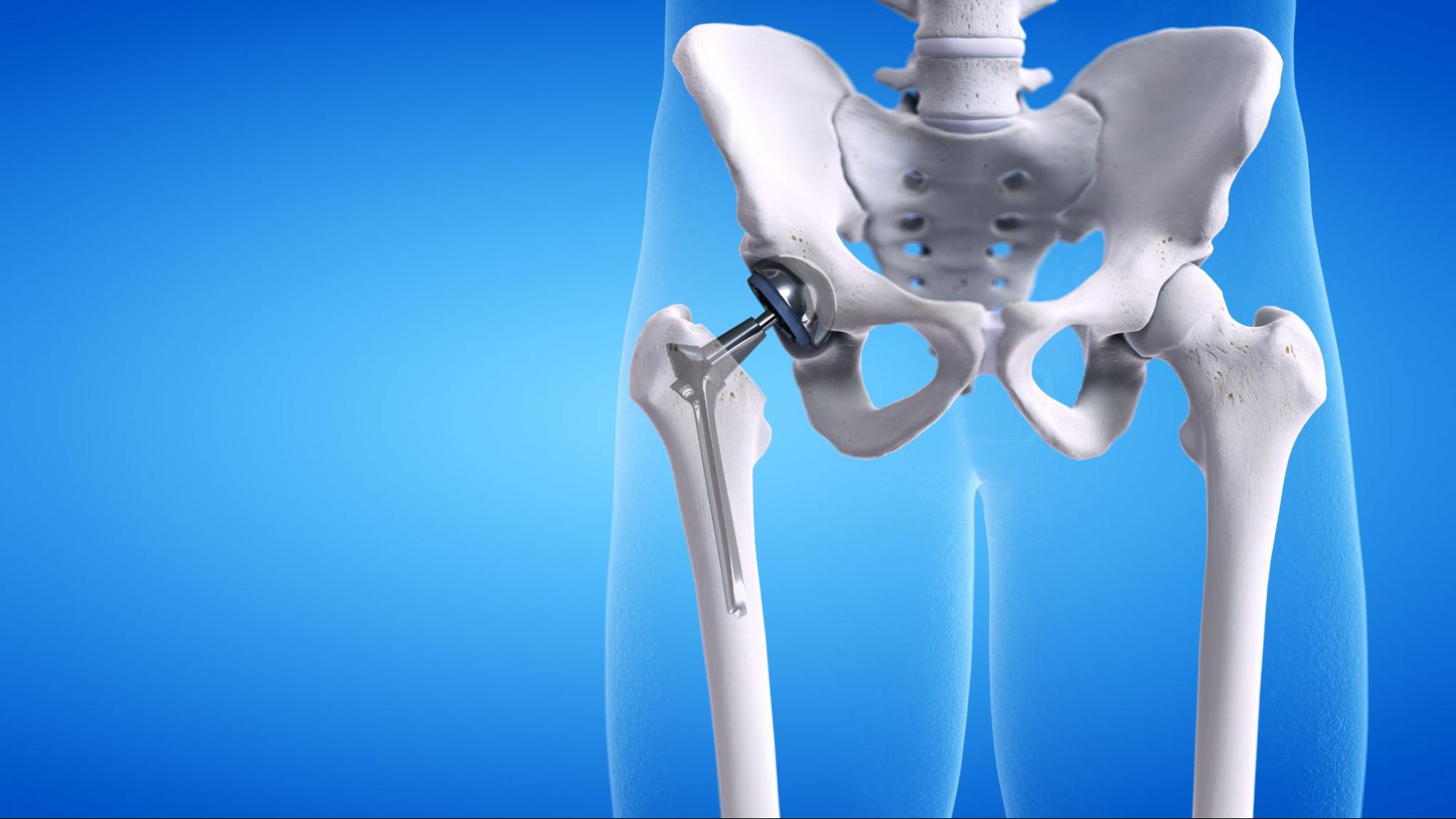
Industrial Machinery
Investment casting supports the industrial machinery sector by enabling the production of stainless steel pump impellers that improve hydraulic efficiency. It is also used to create valve bodies with complex internals that resist corrosion.
Defense
In the defense sector, investment casting is relied upon to produce weapon components made from high-strength alloys, ensuring both reliability and durability in critical applications.
Investment Casting Innovations and Future Trends
As engineering demands grow more complex, investment casting is growing to meet the challenge. From 3D-printed patterns to smart foundries and sustainable practices, the industry is embracing new technologies that boost efficiency, precision, and environmental responsibility. Here’s what’s shaping the future of investment casting:
Integration of 3D Printing for Rapid Prototyping and Pattern Creation
Additive manufacturing revolutionizes pattern creation by enabling rapid prototyping and direct production of complex wax patterns. This technology reduces lead times, eliminates pattern tooling for low-volume runs, and enables the production of customized wax patterns in large quantities, tailored to specific design variations previously unfeasible with traditional methods. Learn how 3D printing services can accelerate the wax pattern creation step.
Advancements in Ceramic Shell Materials for Improved Performance
New ceramic formulations offer enhanced thermal shock resistance, improved dimensional stability, and a superior surface finish transfer to cast parts. These advances expand the range of castable alloys and improve overall process reliability.
Automation and Digitalization in the Casting Process
Smart foundry technologies incorporate sensors, data analytics, and automated handling systems to improve process consistency and reduce labor costs. Digital twin technology enables virtual process optimization before physical production begins.
Sustainability Initiatives and Waste Reduction Strategies
Environmental consciousness drives innovations in ceramic shell recycling, energy-efficient melting systems, and reduced-emission processes. These initiatives lower environmental impact while reducing operational costs.
Selecting the Right Investment Casting Manufacturer
Choosing the appropriate manufacturing partner for investment casting services is crucial for project success. Several key factors should guide your selection process:
- Experience and Certifications: Seek out suppliers with AS9100 (aerospace) or ISO 13485 (medical) certifications and industry-specific expertise.
- Material Capabilities: Confirm proficiency with your required alloys (e.g., titanium, Inconel).
- Quality Control: Ensure that the supplier uses statistical process control and has part inspection capabilities for quality assurance, such as an X-ray machine and a complete metallurgical testing lab.
- Lead Times and Capacity: Verify that the potential supplier can meet your project timelines and volume needs (100–5,000 parts).
- Technical Support: Prioritize partners offering design for manufacturability (DFM) and prototyping with 3D-printed patterns.
Is Investment Casting the Right Manufacturing Process for Your Application?
Investment casting delivers precision, high surface quality, and the ability to make complex metal parts from a wide range of materials for various industries. With typical tolerances around ±0.003″ and surface finishes between 32–63 µin Ra, it’s often well-suited for production volumes in the range of 500–5,000 parts.
While investment casting provides many advantages, it’s important to consider the trade-offs as well. If your project requires higher volumes and faster production cycles, die casting may be a better fit. For lower volumes or early-stage prototypes, CNC machining can offer flexibility and speed without tooling costs.
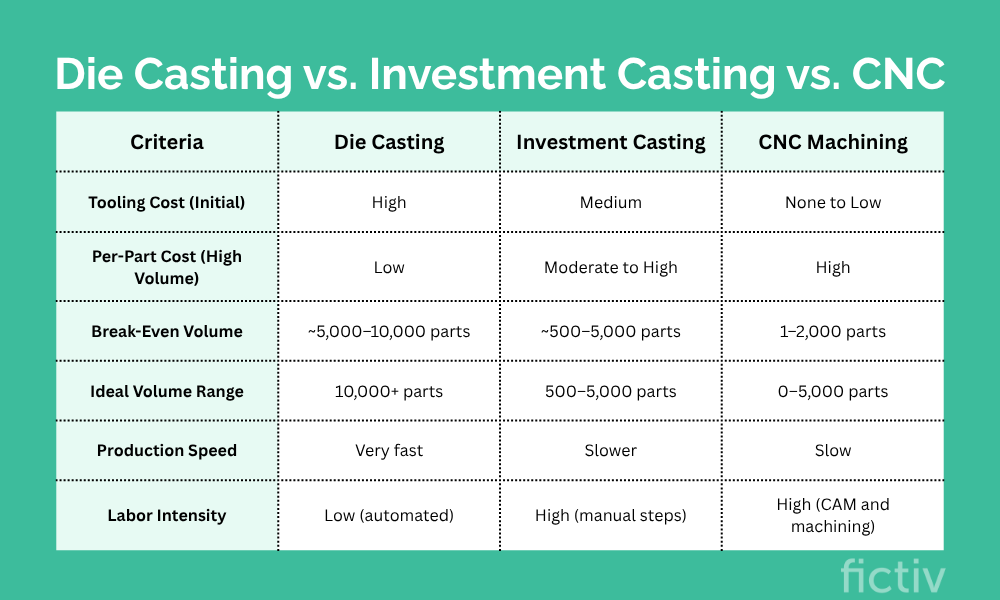
If your design calls for precision metal components with complex features, choosing the right manufacturing process is key. Fictiv’s network of manufacturing partners and technical experts in manufacturing and supply chain can help guide you to the best solution for your project. Looking into investment casting? Just ask—we can provide it on request for specific applications.
Ready to bring your design to life? Get an instant quote through Fictiv’s platform and explore the options that best match your design and production needs.









